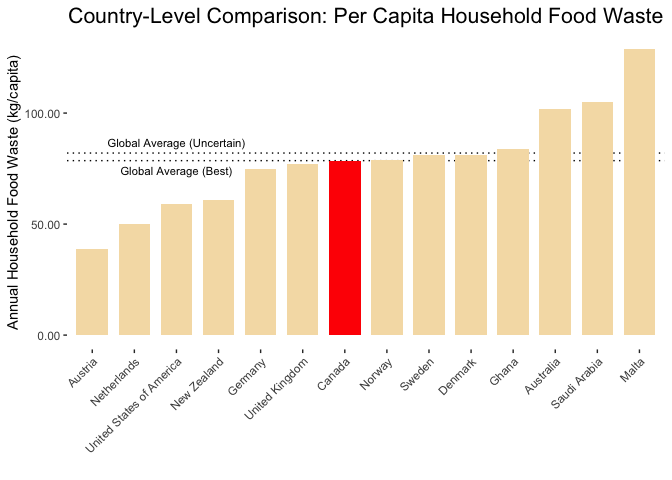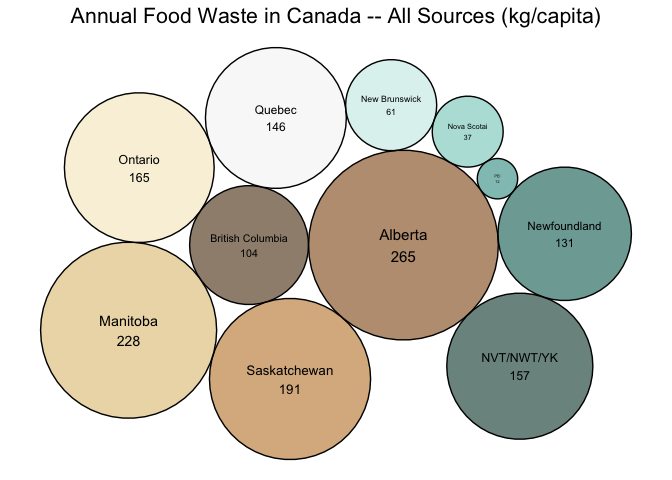Governing Food Waste
Studying food loss and waste can help us to understand why food policymaking is so complex, and might point the way toward using that complexity for the collective good.
Reducing food waste has become a key benchmark for building better food systems. Those systems cannot be sustainable–ecologically, socially, economically–if too much food intended for our plates is left unpicked in the field, spoiled in transit or at the grocery, or forgotten in the fridge.
For many, this seems like a problem that should have clear solutions. Food waste depletes valuable natural resources, contributes to climate change, and is a drag on the economy. If we can convince, support or require people, organizations, businesses and governments to waste less food, we will all, in general, be better off. Who, after all, wants to waste food?
And yet food waste–like so many food system problems–is persistent and it has reached “overwhelming” levels at home and around the world (spring2020?). The United Nations Food and Agriculture Organization (FAO) estimates that about one-third of global food production every year is lost or wasted (Gustavsson et al. 2011).
Why then does food waste continue to be such a difficult challenge? One reason may be that food waste policies are so closely interconnected with other food system rules. Even seemingly straightforward decisions about food waste are inevitably linked to a network of other decisions about issues ranging from agricultural land use to consumer food safety. These links raise the possibility of conflicting interests, information gaps, and uncertainty, creating barriers to reducing food waste even when good policy solutions are readily available.
The good news is that this complexity isn’t always a bad thing. These interconnections also hold the potential for making policy decisions that are more inclusive and more resilient over time.
As part of our project on Governing Regional Food, we are working to build new tools that will help lawmakers, policymakers and advocates in the region better understand the policy landscape of food waste and support them in making collective decisions about their regional food systems. Our initial focus in this work, in support of JustFOOD: An Action Plan for the Halifax Region, is on food waste in the Halifax regional food system. Below we describe some of the data and trends that are motivating our focus on FLW and explain the overarching policy challenge we aim to address in this part of the project.
Food Waste on the Agenda
That food waste needs to be a priority for building better food systems is apparent from the data (even the limited data we currently have available). In Canada, we generate an estimated 13 million tonnes of food waste in total annually (Commission for Environmental Cooperation 2017, xvi). Using a standardized, cross-country measure at the household stage (i.e., after food is acquired for home use), the United Nations estimates that each Canadian wastes on average 79 kilograms of food every year (United Nations Environment Programme 2021). This places Canada at the global average among those 14 countries for which we have the best-available information on household food waste (and slightly below the average for an expanded set of countries for which some less reliable data are available).

Chart Data Source and Notes
Source: (United Nations Environment Programme 2021)
Note: estimates for household food waste can vary, depending on the definitions and methodology used. A study by the National Zero Waste Council, for example, estimates that “the average Canadian household” wastes 140 kilograms per year. Future posts will explore and clarify how these differences might influence work on food waste governance.
| Country | Food Waste Per Capita (kg/yr) | Total Food Waste (tonnes/yr) |
|---|---|---|
| Australia | 102 | 2,563,110 |
| Austria | 39 | 349,249 |
| Canada | 79 | 2,938,321 |
| Denmark | 81 | 469,449 |
| Germany | 75 | 6,263,775 |
| Ghana | 84 | 2,555,332 |
| Malta | 129 | 56,812 |
| Netherlands | 50 | 854,855 |
| New Zealand | 61 | 291,769 |
| Norway | 79 | 423,857 |
| Saudi Arabia | 105 | 3,594,080 |
| Sweden | 81 | 812,948 |
| United Kingdom | 77 | 5,199,825 |
| United States of America | 59 | 19,359,951 |
When other sources of food waste are included (i.e., from retail sources such as restaurants and grocery stores), the Canadian per capita estimate for FLW rises to 161 kilograms annually (Environment and Climate Change Canada 2020, 16). The most recent annual data on food waste from all these sources varies widely across the provinces and territories, from 256 kg/capita in Alberta to 37 kg/capita in Nova Scotia and just 12 kg/capita in PEI.

Chart Data Source
Environment and Climate Change Canada (2020)
| Province/Territory | Food Waste Per Capita (kg/yr) |
|---|---|
| British Columbia | 104 |
| Alberta | 265 |
| Saskatchewan | 191 |
| Manitoba | 228 |
| Ontario | 165 |
| Quebec | 146 |
| New Brunswick | 61 |
| Nova Scotai | 37 |
| PEI | 12 |
| Newfoundland | 131 |
| NVT/NWT/YK | 157 |
As part of its Sustainable Development Goals (SDG 12.3), the United Nations has set an ambitious target to cut global food waste in half at the retail and consumer stages by 2030 (United Nations Environment Programme 2021), and many governments, civil society organizations, businesses and others at all levels are redoubling their efforts to develop and implement laws and policies to achieve this goal. Because of their pivotal role in managing solid waste, local governments and their collaborators are well-placed to be at the forefront of these efforts.
The Policy Challenge: Food Waste in the Food System
There is no shortage of creative and progressive policy ideas for reducing food waste and there are a range of old and emerging technologies that can help us to realize these ideas. But successfully designing and implementing linked food waste policies in the context of the food system as a whole–rather than as isolated initiatives or as waste management decisions divorced from decisions about food–is a central challenge.
Embedded and Adaptive Policymaking
This central policy challenge arises for a few different reasons, each having to do with the basic concept of food as a system. The first reason is that food waste policies are embedded in a network of policies about food. Food policies–including those that directly target food waste–interact and influence one another at multiple levels. Laws and policies around food safety, for example, are generally designed to protect consumers from getting sick from foodborne illnesses. They also allocate liability for outbreaks of foodborne illness in ways that try to deter upstream actors from engaging in risky practices. But these same laws and policies can have dramatic–if unintended–consequences for when, how and which foods get used or thrown away.
Another source of the central policy challenge facing food waste is that the processes generating food and the processes generating policy decisions about food adapt to–feed back into–one another. People working in other fields call this adaptive interdependence a social-ecological system. Regulations that permit organic food waste to be landfilled, for example, can create significant sources of greenhouse gas (GHG) emissions in the form of methane. The climate crises, in turn, is creating a host of food system problems to which embedded and interconnected policies must adapt and respond. People and ecosystems react to the rules and norms established by food policies; food policies must, in turn, adapt to account for these changes.
Why should we care that food wasate policies are embedded and adaptive? Because these features mean that the success or failure of food waste policies will be determined not only by whether they are “good” or “bad” ideas, but also by the structure of the decision processes that dictate how those ideas are made, changed and implemented. For example, these features of the policymaking environment can cause food waste policy to be highly unpredictable. In the face of this uncertainty, some decision processes be easy to dominate by those who have greater material resources or access to information. Other, alternative, decision processes might provide more effective safeguards against such unequal distributions of power.
The optimistic view on all this is that the central policy challenge we’ve identified is also opening up opportunities for different people, organizations, and communities to be heard and, sometimes, to wield new influence over important decisions. Increasingly, at least some food laws and policies are being crafted through more collaborative processes that look very different from conventional top-down, centralized regulatory regimes–regimes which are sometimes ill suited to their tasks and objectives.
Next steps
If we want to create or advocate for effective laws and policies around food waste, we are going to need new tools that, as a first step, tell us how different processes of decision-making fit together, who has influence within these processes, and how the different actors understand the problems or puzzles they are trying to solve. Based on this groundwork, a further step is to understand why some processes work well and why others lead to dysfunctional outcomes.
Drawing on research methods developed to study complex legal and policy networks in other areas like watershed management and climate change, this work supports our partners at JustFOOD: An Action Plan for the Halifax Region to map the policy environment around food waste in the Halifax region. See this post for more details on the method and framework being using for this work.
Sources Cited
Commission for Environmental Cooperation. 2017. “Characterization and Management of Food Loss and Waste in North America.” Montreal, Canada: Commission for Environmental Cooperation.
Environment and Climate Change Canada. 2020. “National Waste Characterization Report: The Composition of Canadian Residual Municipal Solid Waste.” Ottawa: Government of Canada.
Gustavsson, Jenny, Christel Cederberg, Ulf Sonesson, Robert van Otterdijk, and Alexandre Meybeck. 2011. “Global Food Losses and Food Waste: Extent, Causes and Prevention.”
United Nations Environment Programme. 2021. “Food Waste Index Report 2021.” Nairobi: United Nations Environment Programme.